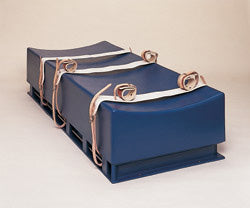The future of behavioural health furniture is changing how healthcare environments are designed for people from all walks of life in mental and emotional crisis. Shifting from the clinical sterility and institutional rigidity of the past, new advancements in this niche category focus on patient-centric design—where safety, comfort and therapeutic support meet.
Behavioural health furniture in Canada has a dramatically different mission than that of traditional health furnishings: to minimize risk and support healing in settings where patient behaviour can be unpredictable. Safety is foundational. From beds and chairs to storage, each piece is designed with anti-ligature properties, a heavy-weight foundation, and non-destroyable. Sharp edges are rounded, hardware is hidden, and surfaces are designed to deter tampering or abuse to promote security and control.

Yet today’s behavioural health environments are not just about reducing risk—they’re also about improving the care experience. One crucial design departure is providing dignity and normality. This can mean employing recognizable forms, soothing colour schemes and inviting finishes that avoid the clinical appearance often associated with psychiatric environments. When the atmosphere feels less punitive and more human, patients are more likely to participate in therapy and respond positively to treatment.
There is a growing demand for flexibility with regard to the design of such care spaces. Today, behavioural health furniture is designed with flexibility in mind—modular seating, movable partitions, multi-purpose furnishings that jump to action for private or group therapy. These customizations expand staff working efficiencies and give flexibility to facilities’ needs to serve more patients.
Beyond safety and comfort, hygiene and durability are essential, especially for equipment exposed to frequent use and rigorous cleaning protocols. Furniture in behavioural health environments needs to be incredibly durable and sanitary. Secondary to the surging focus on infection control practices, these materials have transformed into those that are seamless, moisture barrier resistant and antimicrobial, all in support of infection control practices without sacrificing comfort or safety.
The choice of behavioural health furniture also tends to correlate with evidence-based design principles. Studies have shown that appropriate environments can lead to shorter patient stays, less harm, and better outcomes. That’s why healthcare architects and planners are selecting furnishings designed to help regulate emotions, promote independence of movement, and minimize agitation.
As a nation, we have seen an increase in mental health needs, in addition to other behavioural health needs, which is why behavioural health furniture is no longer considered a niche topic, and instead an essential consideration when designing therapeutic environments suitable for the varying challenges of today’s care models. When form and function are paired with empathy, the result is a space that does more than treat—it heals.
James Foster is the author of this article. For more details about High-quality tactical socks, please visit our website: pspcorp.ca.